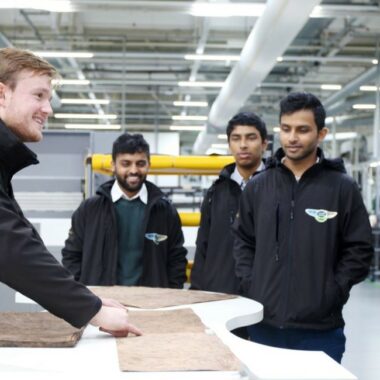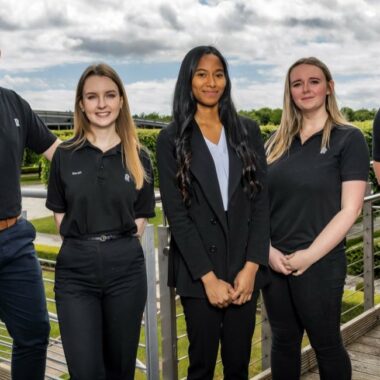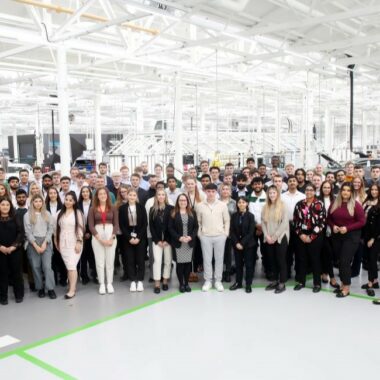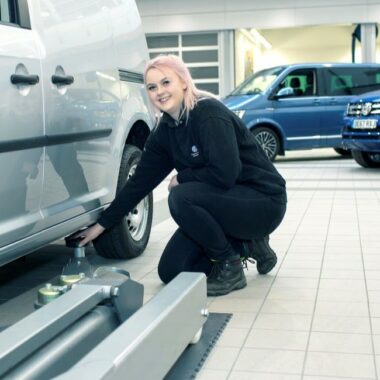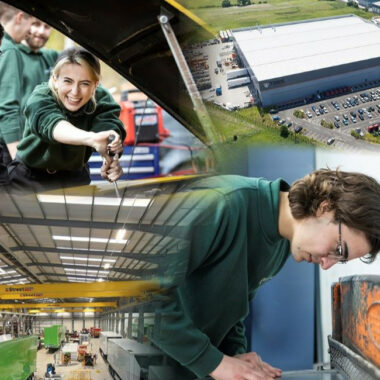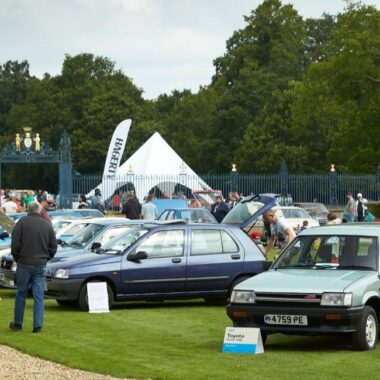The ŠKODA Student Concept Car has been the highlight of the apprentices’ training at the ŠKODA Vocational School since the 2013/14 academic year. With the support of their tutors and experts from all departments at ŠKODA AUTO, they design and build their very own dream car. 25 apprentices have now completed the eighth ŠKODA Student Concept Car, the ŠKODA AFRIQ. At first glance, the spectacular rally version of the ŠKODA KAMIQ city SUV evokes the atmosphere of the legendary Dakar Rally. The name AFRIQ also underlines this association, pointing to ŠKODA AUTO’s responsibility for the Group’s activities in the North Africa region since 1st January 2021.
A lighthouse project of the ŠKODA Vocational School in Mladá Boleslav, the ŠKODA Student Concept Car project has testified to the high standard of training at ŠKODA AUTO every year since 2013/14. The apprentices are supported in planning, designing and building their dream car by tutors and experts from across the company as they transform a ŠKODA production model into a spectacular concept vehicle. This allows the team members to consolidate what they have learned, apply and hone their skills and work collaboratively. At the same time, they are introduced to various processes within the company. For the eighth Student Concept Car, experts from ŠKODA Motorsport played a more prominent role than ever in the project, joining specialists from the Development, ŠKODA Design and Production departments.
Inspiration for launching the project came from Volkswagen, first forerunners in the 1970s
The idea to introduce the Student Concept Car project came from a similar training programme at Volkswagen. At ŠKODA AUTO, the forerunners of today’s Student Concept Cars were produced as early as the 1970s: Besides several small tractors and a ŠKODA 120 pickup, ŠKODA apprentices produced four units of the ŠKODA BUGGY Type 736 in 1975. This model was based on the autocross racing cars, which made their way onto the European motorsport scene and into what was then Czechoslovakia in the late 1960s, with the eponymous racing format. One of these buggies is now on display at the ŠKODA Museum in Mladá Boleslav after being painstakingly restored in 2017 by the ŠKODA Vocational School apprentices.
› Student Concept Cars have been built at the ŠKODA Vocational School since the 2013/14 academic year › 25 apprentices have now completed the eighth Student Concept Car, the ŠKODA AFRIQ › Forerunners of the ŠKODA Student Concept Cars date back to the 70s
Structured over one academic year
Most of the students involved in the project are working on the Student Concept Car in their third year of training. However, the ŠKODA AFRIQ was built over the past two academic years due to COVID-19 restrictions. Under the guidance of their teachers and ŠKODA experts, the vocational students performed all the process steps themselves – from drawing the initial sketches to constructing and assembling the unique vehicle.
From the CITIJET to the SLAVIA – the first seven ŠKODA Student Concept Cars
Built in 2014, the first ŠKODA Student Concept Car was the CITIJET, a two-seater version of the ŠKODA CITIGO. This was followed a year later by the FUNSTAR pickup based on the ŠKODA FABIA. In 2016, the apprentices presented the ATERO, a coupé based on the ŠKODA RAPID SPACEBACK. In 2017, the vocational students designed the electric ELEMENT, the second Student Concept Car derived from the ŠKODA CITIGO. The fifth Student Concept Car in 2018 was the SUNROQ convertible study created from a ŠKODA KAROQ SUV. In 2019, the students transformed a ŠKODA KODIAQ into the impressive MOUNTIAQ pickup, before 2020 saw the creation of the SLAVIA Spider based on the ŠKODA SCALA. The model name marked ŠKODA’s 125th anniversary, recalling the first bicycles produced by Václav Laurin and Václav Klement after the company was founded in 1895.
More Information…
ŠKODA AFRIQ: Student Concept Car No. 8 is set for the rally track
Three, two, one – go! The ŠKODA AFRIQ could enter any special stage of the legendary Dakar Rally off the bat. The eighth ŠKODA Student Concept Car is a spectacular rally version of the ŠKODA KAMIQ. This is the first time the city SUV has served as the basis for a Student Concept Car. The experts from ŠKODA Motorsport were more closely involved in developing the ŠKODA AFRIQ than any other Student Concept Car. The project executed by the 25 apprentices, including three women, pays homage to the roots and the original home of the ‘Dakar’ and at the same time points to ŠKODA AUTO’s responsibility for Volkswagen Group activities in North Africa.
Maren Gräf, ŠKODA AUTO Board Member for People & Culture, emphasises: “Our Student Concept Car this year, the ŠKODA AFRIQ, is the impressive result of the tremendous creativity and talent of our up-and-coming employees. The ŠKODA AUTO Vocational School prepares them in the best possible way for their career at ŠKODA AUTO, giving them the opportunity to apply and consolidate what they have learned at an early stage in their practice-based training. I am especially pleased with our apprentices’ high level of innovation, which also has sustainability at its core. I am confident that with these committed young professionals, we are in an excellent position to shape the future of our company together and make our transformation a success.”
Since 1st January 2021, ŠKODA AUTO has been responsible for all the Group’s activities in Egypt, Tunisia, Morocco and Algeria and is opening up new markets with growth potential in the region. As part of its NEXT LEVEL – ŠKODA STRATEGY 2030, ŠKODA AUTO is striving to become the leading European car manufacturer in the growth markets of India and North Africa by 2030 under the banner of ‘EXPLORE’. The ŠKODA AFRIQ Student Concept Car increases awareness of this responsibility for the North Africa region.
Challenging conditions due to the COVID-19 pandemic
25 apprentices from the ŠKODA AUTO Vocational School, including three women, began working on the eighth Student Concept Car project in autumn 2020 and quickly decided on an all-wheel-drive rally version of the ŠKODA KAMIQ city SUV. However, due to the COVID-19 pandemic and the associated restrictions, the apprentices were initially only able to meet online, so the planning and design phase for the Student Concept Car was prolonged by three months to April 2021. For this reason, the date for completing the vehicle was also postponed from June 2021 to May 2022, and the entire project was extended from one academic year to two – 2020/21 and 2021/22. ŠKODA fans, therefore, had to wait a year longer for the successor to the Spider ŠKODA SLAVIA.
2,000 hours’ work to build the ŠKODA AFRIQ
It took four months to build the ŠKODA AFRIQ, and the apprentices invested around 2,000 working hours. The body of the basic KAMIQ model was fundamentally reshaped: The rear doors of the city SUV were welded and the wings, wheel arches and bumpers of the two-door AFRIQ were enlarged. In addition, the suspension was reinforced. The extensive adaptations required to install the all-wheel drive from a ŠKODA OCTAVIA 4×4 were also very time-consuming. As in previous years, the structural body adjustments were particularly complex; the students had to level out the body, reshape all the edges of the vehicle and fill all the joints to shape the body perfectly.
Broadest collaboration with ŠKODA Motorsport in the history of the Student Concept Car project
Alongside a host of engineers and staff from the Technical Development, Design and Production departments, the apprentices also received support from experts in the ŠKODA Motorsport team. Given that the ŠKODA AFRIQ is a rally vehicle, ŠKODA Motorsport was more heavily involved in developing the model than ever before in the history of the ŠKODA Student Concept Car project. The experts from ŠKODA Motorsport shared their technical knowledge with the apprentices and supplied them with equipment. For example, they provided additional headlights, as well as ventilation and the tailgate with an integrated spoiler from the ŠKODA FABIA Rally2 evo and quick-release fasteners for the bonnet. Several other features from the ŠKODA FABIA Rally2 evo can be found onboard, including two cameras with microphones, the steering wheel, dashboard, six-point seat belts and special racing seats.
Design: inspired by the FABIA Rally2 evo with striking wheels
The ŠKODA AFRIQ confidently expresses its rally genes. Many of the visual details of this unique vehicle are based on the design of the world’s most successful racing car, the ŠKODA FABIA Rally2 evo. The eighth Student Concept Car stands on 15-inch ‘OZ Racing’ wheels. The white paintwork with coloured racing-style stickers are also eye-catching; they were created by the vocational students in collaboration with ŠKODA Design. The interior, which has been stripped down to the essentials, unmistakably resembles ŠKODA’s motorsport models. The highlights include two cameras and an innovative drinking water generator produced by the Israeli company Watergen.
Inspired by the ŠKODA FABIA Rally2 evo, the eighth Student Concept Car displays real motorsport flair at first glance: like the ŠKODA FABIA Rally2 evo, the ŠKODA AFRIQ is painted white and sports colourful stickers in true racing style. The apprentices designed these stickers in a joint project with ŠKODA Design. The 15-inch ‘OZ Racing’ wheels also underscore its dynamic appeal.
From four-door to two-door
Unlike the original KAMIQ model, the ŠKODA AFRIQ is a two-door model. To stiffen the body, the apprentices welded the two rear doors and connected them directly to the roll cage specially designed for the Student Concept Car. Just like the FABIA Rally2 evo, a ventilation flap is integrated into the roof, and the rear spoiler also comes from the successful WRC2 racing car from Mladá Boleslav. Other parallels to the rally FABIA include the additional headlights at the front and special quick-release fasteners on the bonnet and tailgate. The ŠKODA AFRIQ is 4,362 millimetres long, 1,870 millimetres wide and 1,570 millimetres high; it has a wheelbase of 2,649 millimetres and a ground clearance of 190 millimetres.
Bucket seats, seat belts and steering wheel from the ŠKODA FABIA Rallye2 evo
When it came to kitting out the car, the apprentices enlisted the help of experts from ŠKODA Motorsport. The racing bucket seats, six-point seat belts, steering wheel and dashboard were taken directly from the ŠKODA FABIA Rallye2 evo. No rally car would be without a roll cage, and the AFRIQ’s features a custom-built unit, benefitting from a fire extinguishing system which is installed behind the passenger seat. The outlet nozzles for the extinguishing agent are distributed throughout the interior.
Navigation system, cameras and a water generator
Other special details onboard include a rally-ready navigation system. Two cameras are also mounted to record spectacular drives. These also have microphones and store the recorded driving scenes on memory cards. One camera is located between the two seats near the roof, the second is fixed to the left A-pillar above the dashboard. Another innovative highlight is the water generator from the Israeli company Watergen, which extracts drinking water from atmospheric air. This means that the driver and co-driver always have drinking water available in the ŠKODA AFRIQ, similar to a water dispenser – fresh, filtered, mineralised, healthy and completely independent of the vehicle’s environment. The ŠKODA AUTO DigiLab and the company’s in-house InnoPOC programme for testing innovative technologies supported the technology’s integration into the vehicle. ŠKODA AUTO DigiLab Israel scouted and tested the technology jointly with the Inno team and then made recommendations on its potential use. This is how the successful collaboration with the ŠKODA Academy came about.
Drivetrain: Power to all four wheels for all-terrain traction
In the AFRIQ, the vocational students have combined technical components from the ŠKODA KAMIQ, which was used as the basis, a ŠKODA OCTAVIA and the rally model ŠKODA FABIA Rally2 evo. The body comes from the KAMIQ and the rally FABIA supplied numerous components, particularly in the interior. The drivetrain from a ŠKODA OCTAVIA 4×4 provides the power for the eighth Student Concept Car. A 7-speed DSG distributes the 140 kW (190 hp) output and maximum torque of 320 Nm to all four wheels. The ŠKODA AFRIQ is thus ideally suited for off-road use.
Traditionally, participants in the Student Concept Car project use engineering components from other ŠKODA vehicles and adapt them to build their dream car. This is particularly true of the ŠKODA AFRIQ’s drivetrain: the engine and transmission come from a ŠKODA OCTAVIA 4×4. The 2.0 TSI four-cylinder generates 140 kW (190 hp) and a maximum torque of 320 Nm. The power is distributed to all four wheels via a 7-speed DSG. The exhaust system has been modified to complement the new engine and modified underbody.
Installing the drivetrain from a ŠKODA OCTAVIA 4×4 required extensive modifications to the underbody. The brackets for the front axle and the engine and transmission mounts were adapted, as the OCTAVIA’s engine is larger than the KAMIQ’s. A new multi-link rear axle was also fitted. To accommodate the axle brackets, a component from the rear of the OCTAVIA’s bodyshell was integrated into the KAMIQ’s. ŠKODA Academy technicians used the two-part tank from the OCTAVIA to fit the cardan shaft and had to modify the tank opening and filler neck for this purpose. The cardan shaft was shortened to fit the KAMIQ. The gearbox and exhaust were also modified to save space. The redesigned tailpipes of the exhaust system make a striking feature at the rear. The interior of the AFRIQ has been stripped back to meet the requirements of rally drivers and thus makes a significant contribution to the vehicle’s low weight of just 1,350 kilograms.
Watergen: Fresh and filtered water onboard – anytime, anywhere
The ŠKODA AFRIQ boasts a drinking water generator from Watergen. The innovative company from Israel has grown from a local technology company to one of the world’s leading suppliers of atmospheric drinking water treatment systems. With its patented process, Watergen extracts drinking water from the humidity of the ambient air and can thus generate drinking water even in a desert.
Under the expert supervision, the apprentices from the ŠKODA Vocational School have added a very special detail to the ŠKODA AFRIQ with the drinking water generator from Watergen: the racing vehicle designed for the desert rally can provide its occupants with clean and chilled drinking water whenever they need it. By installing a unit in the AFRIQ, ŠKODA AUTO is raising awareness of this technology that can help to combat water shortages in desert regions such as North Africa. In addition, eliminating the need for single-use water bottles reduces plastic waste and thus the carbon footprint.
The four-step water extraction process
Generating drinking water from atmospheric moisture is one of the most important and innovative methods of water production. Watergen is a pioneer in this field and has patented its technology. Founded in 2009, the company owns a total of 42 patents and distributes its products in more than 85 countries. Watergen also works with governments and NGOs to address water scarcity in many regions of the world. There are four steps in Watergen’s process for extracting water from the air: First, a fan sucks in the air; an integrated filter removes dust and dirt. The purified air is passed through the GENius heat exchanger, where it condenses the water. The water then passes through a cascade filter for a further purification and mineralisation. During this process, UV light destroys microorganisms and breaks down harmful chemicals. The water is then stored in a reservoir where it circulates continuously. UV light is again utilized to kill any residual viruses and bacteria.
Installation in the ŠKODA AFRIQ
The Watergen portfolio includes various products for industrial and private use, as well as versions with an internal water tank for in-vehicle operation. The ŠKODA AFRIQ employs a customised solution using existing components. The tank is located on the left side of the tailgate in the same box as the water filtration, mineralisation and UV treatment. The cup holder, dispenser and control display are all linked and mounted on the dashboard. The water flows into the cup and is stopped at the push of a button. At the same time, the display shows the fill level of the water tank as well as the ambient air temperature and humidity. The main unit, which includes the fan, air filter, GENius heat exchanger, condenser and compressor, is located behind the two seats in the rear of the AFRIQ. This is where the air is drawn in, cooled and condensed into water. The system is fully integrated into the vehicle and can produce up to 20 litres of drinking water a day, depending on external conditions such as air temperature and humidity. Watergen’s largest stationary systems can produce up to 6,000 litres of water every day.
ŠKODA Academy: First-class training and further education
ŠKODA AUTO has a long history of training its up-and-coming talent. The company founded the ŠKODA Vocational School at its headquarters in Mladá Boleslav back in 1927. Since then, almost 24,000 apprentices have graduated from the institute. As of the 2021/22 academic year, around 900 apprentices are enrolled on 19 technical courses, focusing on mechanical and electrical engineering. The ŠKODA Student Concept Car is the ŠKODA Vocational School’s lighthouse project; every year since the 2013/14 academic year, young professionals have been able to design and build their very own dream car.
For 95 years now, ŠKODA AUTO has been firmly committed to training its next generation of employees. As early as 1927, the company founded the ŠKODA Vocational School at its headquarters in Mladá Boleslav, which quickly gained national recognition thanks to the high standard of training offered. Nowadays, the ŠKODA Vocational School is a private ŠKODA AUTO facility. Since 2013, it has been a central pillar of the ŠKODA Academy, which, in addition to providing training, also ensures the continuous professional development of skilled workers.
58 students in the inaugural class, around 24,000 graduates to date
In 1927, there were 58 students in the ŠKODA Vocational School’s first class. They received training in three subject areas. In the 2021/22 academic year, the institution has almost 900 students, over twelve per cent of whom are women. There are currently 19 technical training courses to choose from, with a focus on mechanical and electrical engineering and a special emphasis on emerging technologies. The apprenticeships for car mechanics, car electricians and IT mechatronics are in particularly high demand. In addition to in-company training, apprentices also have the opportunity to complete an internship abroad at another Group brand. To date, almost 24,000 students have successfully completed their training at the ŠKODA Vocational School. ŠKODA AUTO offers every graduate a permanent position at the company. Employees can also undertake follow-up and advanced training courses at the institution.
Major investment in the ŠKODA Academy
ŠKODA AUTO attaches great importance to the continuous education and training of its employees under optimal conditions. Since signing a memorandum in support of technical training at ŠKODA in February 2014, the company – with the support of the KOVO trade union – has invested more than 370 million Czech crowns (around €14.5 million) in the ŠKODA Academy. The funding has enabled the training facilities to be expanded, modernised and equipped with cutting-edge technology and comprehensive training programmes to be offered.






















